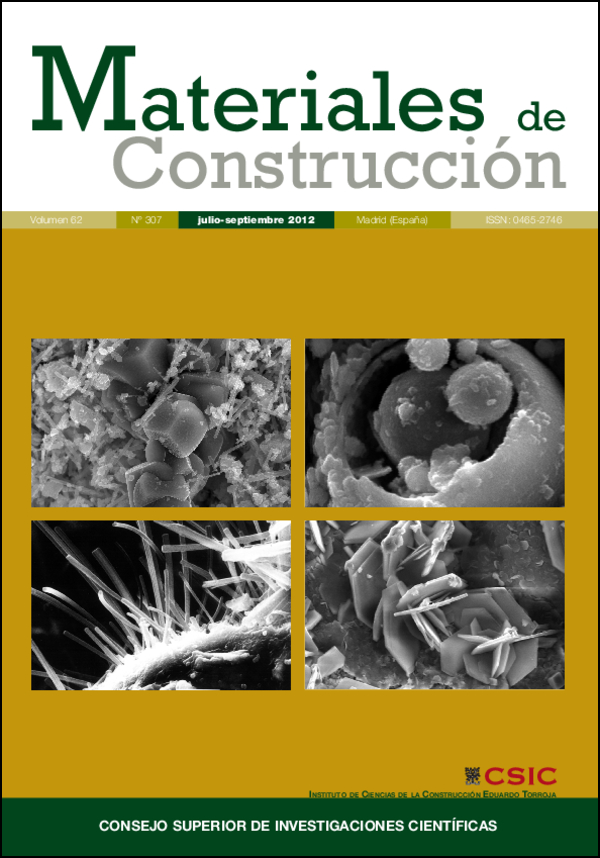Evaluación de la influencia de la rugosidad superficial sobre la colonización epilítica de calizas mediante técnicas sin contacto
DOI:
https://doi.org/10.3989/mc.2012.64410Palabras clave:
piedra, rugosidad superficial, colonización epilítica, técnicas no destructivasResumen
La colonización de la piedra por microorganismos ha generado una extensa literatura sobre los mecanismos y tasas de degradación fisicoquímica de las superficies pétreas, tanto en laboratorio como en estudios de campo. La colonización biológica de piedra de construcción depende de parámetros intrínsecos como son su composición mineral, textura, porosidad y permeabilidad, así como de parámetros ambientales. Este estudio demuestra la relación entre la rugosidad superficial de la piedra y la colonización epilítica, cuantificada en tres tipos de caliza mediante técnicas no destructivas: medida de la rugosidad superficial usando un perfilómetro óptico y análisis digital de imágenes. De acuerdo con la rugosidad media aritmética (Ra) y la amplitud media de rugosidad (Rz), determinadas para la caliza de Ançã, la caliza de Lioz y la piedra de Lecce, puede concluirse que las piedras con alta rugosidad superficial son más propensas a la colonización microbiana.
Descargas
Citas
(1) Guillitte, O.: “Bioreceptivity: “A new concept for building ecology studies”, Sci. Total Environ., vol. 167 (1995), pp. 215-220. http://dx.doi.org/10.1016/0048-9697(95)04582-L
(2) Bellinzoni, A. M.; Caneva, G.; Ricci, S.: “Ecological trends in travertine colonisation by pioneer algae and plant communities”, Int. Biodet. Biodegr., vol. 51 (2003), pp. 203-210. http://dx.doi.org/10.1016/S0964-8305(02)00172-5
(3) Gorbushina, A. A.: “Life on the rocks”, Environ. Microbiol., vol. 9 (2007), pp. 1613-1631. http://dx.doi.org/10.1111/j.1462-2920.2007.01301.x PMid :17564597
(4) Guillitte, O.; Dreesen, R.: “Laboratory chamber studies and petrographical analysis as bioreceptivity assessment tools of building materials”, Sci. Total Environ., vol. 167 (1995), 365-374. http://dx.doi.org/10.1016/0048-9697(95)04596-S
(5) Silva, B.; Prieto, B.; Rivas, T.; Sánchez-Biezma, M. J.; Paz, G.; Carhallal, R.: “Rapid biological colonization of a granitic building by lichens”, Int. Biodet. Biodegr., vol. 40 (1997), pp. 263-267. http://dx.doi.org/10.1016/S0964-8305(97)00051-6
(6) Tomaselli, L.; Lamenti, G.; Bosco, M.; Tiano, P.: “Biodiversity of photosynthetic micro-organisms dwelling on stone monuments”, Int. Biodet. Biodegr., vol. 46 (2000), pp. 251-258. http://dx.doi.org/10.1016/S0964-8305(00)00078-0
(7) Prieto, B.; Silva, B.: “Estimation of the potential bioreceptivity of granitic rocks from their intrinsic properties”, Int. Biodet. Biodegr., vol. 56 (2005), pp. 206-215. http://dx.doi.org/10.1016/j.ibiod.2005.08.001
(8) Scardino, A. J.; Guenther, J.; De Nys, R.: “Attachment point theory revisited: the fouling response to a microtextured matrix”, Biofouling, vol. 24 (2008), pp. 45-53. http://dx.doi.org/10.1080/08927010701784391 PMid :18066730
(9) Scardino, A. J.; Harvey, E.; De Nys, R.: “Testing attachment point theory: diatom attachment on microtextured polyimide biomimics”, Biofouling, vol. 22 (2006), pp. 55-60. http://dx.doi.org/10.1080/08927010500506094 PMid :16551561
(10) Alonso, F. J.; Vázquez, P.; Esbert, R.; Ordaz, J.: “Ornamental granite durability: evaluation of damage caused by salt crystallization”, Mater. Construcc., vol. 58 (2008), pp. 191-201.
(11) Hodson, M. E.; Lee, M. R.; Parsons, I.: “Origins of the surface roughness of unweathered alkali feldspar grains”, Geochim. Cosmochim. Acta, vol. 61 (1997), pp. 3885-3896. http://dx.doi.org/10.1016/S0016-7037(97)00197-X
(12) Tiano, P.; Accolla, P.; Tomaselli, L.: “Phototrophic biodeteriogens on lithoid surfaces: An ecological study”, Microb. Ecol., vol. 29, (1995), pp. 299-309. http://dx.doi.org/10.1007/BF00164892
(13) Bergey, E. A.: “Measuring the surface roughness of stream stones”, Hydrobiologia, vol. 563 (2006), pp. 247-252. http://dx.doi.org/10.1007/s10750-006-0016-4
(14) Poon, C. H.; Bhushan, B.: “Comparison of surface roughness measurements by stylus profiler, AFM and non-contact optical profiler”, Wear, vol. 190 (1995), pp. 76-88. http://dx.doi.org/10.1016/0043-1648(95)06697-7
(15) Grissom, C. A.; Charola, A. E.; Wachowiak, M. J.: “Measuring surface roughness on stone: back to basics”, Stud. Conserv.; vol. 45 (2000), pp. 73-84. http://dx.doi.org/10.2307/1506665
(16) Benavente, D.; Martínez-Verdú, F.; Bernabeu, A.; Viqueira, V.; Fort, R.; García del Cura, M. A.; Illueca, C.; Ordóñez, S.: “Influence of surface roughness on color changes in building stones”, Color Res. Appl., vol 28 (2003), pp. 343-351. http://dx.doi.org/10.1002/col.10178
(17) Miller, A. Z.; Leal, N.; Laiz, L.; Rogerio-Candelera, M. A.; Silva, R. J. C.; Dionisio, A.; Macedo, M. F.; Saiz-Jiménez, C.: “Primary bioreceptivity of limestones used in Southern Europe monuments”, in B. J. Smith, M. Gómez-Heras, H. A. Viles, J. Cassar (eds.), Limestone in the Built Environment: Present Day Challenges for the Preservation of the Past (2010), Geological Society Special Publications, London, vol. 331, pp. 79-92.
(18) ISO 4287:1984. Surface roughness-terminology: Part 1. Surface and its parameters. International Organization for Standardization.
(19) Mark, R.; Billo, E.: “A stitch in time: Digital panoramas and mosaics”, in Freers, S. M. (ed.), American Indian Rock Art, vol. 25 (1999), pp. 155-168.
(20) Sezgin, M.; Sankur, B.: “Survey over image thresholding techniques and quantitative performance evaluation”, J. Electron. Imaging, vol. 13 (2004), pp. 146-165. http://dx.doi.org/10.1117/1.1631315
(21) Roeselers, G.; Zippel, B.; Staal, M.; Van Loosdrecht, M.; Muyzer, G.: “On the reproducibility of microcosm experiments —Different community composition in parallel phototrophic biofilm microcosms”, FEMS Microbiol. Ecol., vol. 58 (2006), pp. 169-178. http://dx.doi.org/10.1111/j.1574-6941.2006.00172.x PMid :17064259
(22) Donlan, R. M.: “Biofilms: microbial life on surfaces”, Emerg. Infect. Dis., vol. 8 (2002), pp. 881-890. http://dx.doi.org/10.3201/eid0809.020063 PMid :12194761 PMCid:2732559
(23) Morton, L. H. G.; Greenway, D. L. A.; Gaylarde, C. C.; Surman, S. B.: “Consideration of some implications of the resistance of biofilms to biocides”, Int Biodet. Biodegr., vol. 41 (1998), pp. 247-259.
Descargas
Publicado
Cómo citar
Número
Sección
Licencia
Derechos de autor 2012 Consejo Superior de Investigaciones Científicas (CSIC)

Esta obra está bajo una licencia internacional Creative Commons Atribución 4.0.
© CSIC. Los originales publicados en las ediciones impresa y electrónica de esta Revista son propiedad del Consejo Superior de Investigaciones Científicas, siendo necesario citar la procedencia en cualquier reproducción parcial o total.
Salvo indicación contraria, todos los contenidos de la edición electrónica se distribuyen bajo una licencia de uso y distribución “Creative Commons Reconocimiento 4.0 Internacional ” (CC BY 4.0). Consulte la versión informativa y el texto legal de la licencia. Esta circunstancia ha de hacerse constar expresamente de esta forma cuando sea necesario.
No se autoriza el depósito en repositorios, páginas web personales o similares de cualquier otra versión distinta a la publicada por el editor.
















